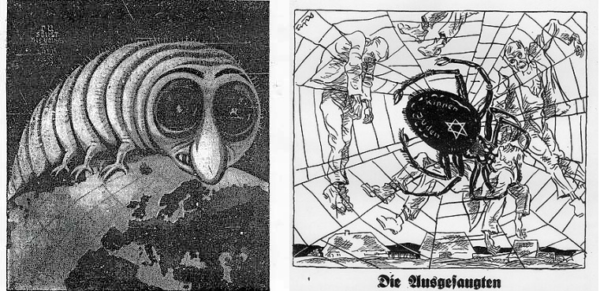
New York Times columnist Thomas Friedman had a piece in the Point (2/2/24), an online Times feature the paper describes as “conversations and insights about the moment,” that compared the targets of US bombs to vermin. It’s the sort of metaphor that propagandists have historically used to justify genocide.

Thomas Friedman (New York Times, 2/2/24): “Sometimes I contemplate the Middle East by watching CNN. Other times, I prefer Animal Planet.”
Friedman’s piece compared the nation of Iran to “a recently discovered species of parasitoid wasp,” which (according to Science Daily) “injects its eggs into live caterpillars, and the baby wasp larvae slowly eat the caterpillar from the inside out, bursting out once they have eaten their fill.” Friedman asks:
Is there a better description of Lebanon, Yemen, Syria and Iraq today? They are the caterpillars. The Islamic Revolutionary Guard Corps is the wasp. The Houthis, Hezbollah, Hamas and Kataib Hezbollah are the eggs that hatch inside the host—Lebanon, Yemen, Syria and Iraq—and eat it from the inside out.
Is there a better way to describe distinct political movements in four different Mideast nations, each with a social base in a minority or majority population of those countries, than by comparing them to flesh-eating parasites injected by a foreign insect? Well, yeah—lots of them.
But Friedman’s framing of Iranian allies as vermin naturally leads him to call for an eliminationist solution: “We have no counterstrategy that safely and efficiently kills the wasp without setting fire to the whole jungle.”
‘Analogies from the natural world’

Likening Hamas to a spider, Friedman followed in the footsteps of the Nazi newspaper Der Sturmer (2/1930), which in this cartoon suggested that gentiles were “sucked dry” by Jews.
Friedman was not done with his vermin analogies. Hamas is not only a parasitic wasp larva, he wrote, but is also “like the trap-door spider,” since they are “adept at camouflaging the doors of their underground nests, so they are hard to see until they’re opened.” (Elsewhere—New York Times, 12/1/23—Friedman has argued that the war against Hamas has already succeeded, since Israel has made its point that if “you destroy our villages, we will destroy yours 10 times more”—a suitable message for the Middle East, he suggested, which “is a Hobbesian jungle…not Scandinavia.”)
Comparing various Muslim political movements to creepy invertebrates was part of Friedman’s musings about how he “sometimes prefer[s] to think about the complex relations between [Mideastern] parties with analogies from the natural world.” Strikingly, however, the comparisons to loathsome arthropods were reserved for nations and militant groups—like Hamas, Yemen’s Houthis, and Iranian allies in Iraq and Syria—that US-made bombs are currently falling on.
The US itself appears in the column as an “old lion,” “still the king of the Middle East jungle,” but with “so many scars from so many fights” that “other predators are no longer afraid to test us.”
And Benjamin Netanyahu, who as prime minister of Israel is responsible for killing more than 27,000 people, most of them civilians, and wounding nearly 67,000 more, is compared to a lemur, because he’s “always shifting side to side to stay in power.”
Conceived as subhuman

Captioning the antisemitic cartoon “Vermin,” Der Sturmer (9/28/1944) described Jews as “the parasite, never satisfied as it creeps about.”
The comparison of official enemies to vermin is a hallmark of propaganda in defense of genocide. The group Genocide Watch lists “dehumanization” as the fourth of ten stages of genocide, in which members of a targeted group “are equated with animals, vermin, insects or diseases” in a process that “overcomes the normal human revulsion against murder.”
“It’s very difficult, psychologically, to kill another human being,” David Livingstone Smith, author of a book on dehumanization called Less Than Human, told NPR (3/29/11). “When people dehumanize others, they actually conceive of them as subhuman creatures,” Smith said, allowing would-be genocidaires to “exclude the target of aggression from the moral community.”
Thus the Nazis compared Jews to an array of despised creatures, including spiders and parasitic insects. In Rwanda, the radio station RTLM paved the way for mass slaughter by repeatedly referring to the Tutsi minority as “cockroaches” and “snakes” (Atlantic, 4/13/19). In Myanmar, the anti-Rohingya agitator Ashin Wirathu compared Muslims to snakes, dogs and invasive catfish (Daily Beast, 10/13/17).
Surely editors at the New York Times are aware of this history. Given that the International Court of Justice recently ruled that it’s “plausible” that Israel is committing genocide in Gaza (NPR, 1/26/24), shouldn’t the Times avoid echoing the arguments that have historically been used to make genocide more palatable?
